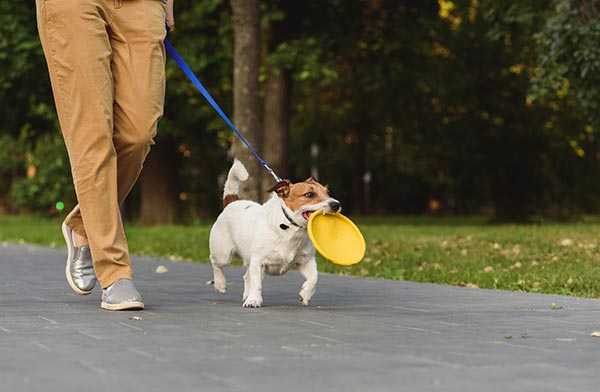Does My Dog Need Longer Walks?

Like all good dog owners, you want to make sure your pup is happy and healthy. Regular veterinary care, quality food and loving care are all part of the equation, but so is exercise, and the easiest, as well as the most popular way to exercise your dog, is through walks.
How can you be sure your dog is getting enough exercise, how much is enough, and what happens if they don’t get it? Keep reading to find out!
What Can Happen if My Dog Doesn’t Get Enough Exercise?
Just like people, dogs can become overweight without physical activity. But, it can create other problems for our canine friends and you, including:
- Destructive behaviors like chewing on shoes or furniture, eliminating in the house, getting into the trash, destroying items in the household, or increased aggression toward people or other pets can be caused by lack of exercise. However, there are other things that can also cause this type of behavior, so call us to make an appointment so we can pinpoint the source.
- Some dogs will become withdrawn when they’re not getting enough physical stimulation. If your dog was very social, and no longer runs to the door in anticipation of a walk or acts disinterested when you enter the room, they could be depressed. Again, there are other things that can cause this behavior, so pay us a visit.
- Hyperactivity when they are on a walk. If your dog gets over-excited when you take out their leash or when you’re about to head out the door, it may be a sign of restlessness and a need for more physical activity. Excessive leash pulling can also mean that your dog needs to burn more energy. That being said, leash pulling can be caused by other things, so consult a trainer.
- Your dog may bark and whine a lot if they aren’t getting enough exercise.
But How Do I Know How Long a Walk My Dog Needs?
Every dog, just like every person, is unique, but what breed (or breeds, in the case of mixed breeds), age, size and overall health can tell you a lot. Also, a general rule-of-thumb is that your dog should spend between 30 minutes and two hours being active every day.
A general guide for exercise per breed size is:
- Small breeds. This group includes dogs from the Chihuahua to the Bichon or Shih Tzu. They have moderate exercise needs with a daily walk of 20 to 30 minutes. The exception would be the toy and miniature poodle which are more active and also intelligent, so require a little more physical activity and plenty of mental stimulation.
- Sight hounds. These include the Greyhound, Whippet and the Wolfhound. Even though the Greyhound is a racing dog, they’re bred for sprinting and only need moderate exercise. A moderate pace walk of around 30-to-45 minutes a day and maybe some short sprints is enough to keep them healthy.
- Giant Breeds. The Giant breeds include the Leonberger, Newfoundland, Great Dane, and Saint Bernard. They have moderate exercise needs because they have to move such a large frame. However, it is important to still be moderately active to keep their joints and bones strong and for weight management. A 30-to-45 minute walk is sufficient. Also, many of the giant breed dogs are keen swimmers, so swimming is a great exercise for them because it’s low weight-bearing.
The dogs who need the most exercise – 60-to-120 minutes daily – are:
- Sporting breeds, like Retrievers and Springer Spaniels, Standard Poodles.
- Working breeds, such as Dobermans, Huskies and Rottweilers.
- Herding breeds, like Sheepdogs, Collies, Shepherds, Cattle Dogs, Heelers and Corgis.
Others need 60-to-90 minutes per day:
- Terrier and Vermin Breeds, which include Bull Terriers, Airedale Terriers and smaller terriers such as Jack Russels, Yorkshire Terriers and Westies.
- Scent Hounds, like Beagles and Basset Hounds.
Dogs that need little exercise are brachycephalic dogs – those with a squashed face like Bulldogs and Pugs. Because they have pushed-in faces, they are prone to overheating. They require a 20-to-30 minute walk a day.
The Bottom Line
All dogs need daily exercise to stay happy and healthy. If you’re just starting a walking routine with your dog, start slowly. Observe their responses, and add longer walks as they get stronger. Your dog should be happily tired and not exhausted. And remember that increased activity doesn’t mean they need more food!
If you have any concerns about whether your dog can handle a long walk or whether you should implement a dog exercise plan for her, give us a call for an appointment and expert advice.
Keeping up with routine veterinary care visits is arguably the most important part of responsible pet ownership. Routine veterinary checkups can provide insight into any changes in your pet’s health, and give you an opportunity to ask any questions you may have about your dog and their current life stage.
If you are unsure of when your pet’s last vet visit was, don’t have a current vaccination record, or have questions about your pet’s health, don’t hesitate to contact us at Academy Animal Hospital. We’re committed to keeping Greenwood area pets healthy and happy.
